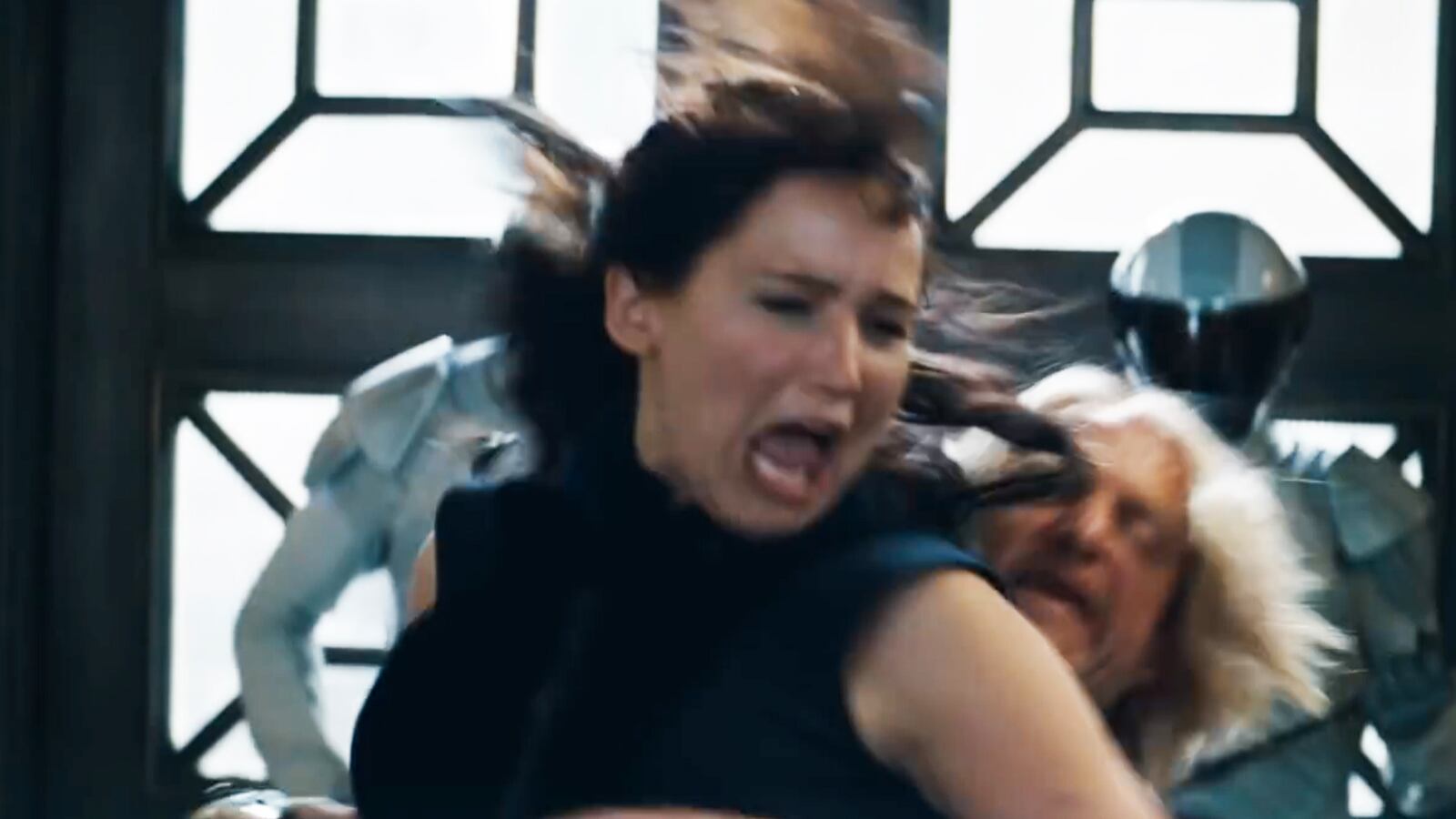A gruesome whipping scene is about to unfold. You half expect—and hope—that it will just be heard and won’t be shown. The tormentor stands above the victim, who’s cowering and bracing for the lash. But the whip flies through the air and, no luck, the camera lingers on the mangled back. We see torn skin. Blood drips from the whip.

The scene is not from 12 Years a Slave, but The Hunger Games: Catching Fire. The film, which cradles a PG-13 rating despite being about kids killing kids, isn’t very violent. The camera turns away before heads are smashed; bloodthirsty baboons snarl but are never seen ripping into a jugular. Yet in this brutal scene where Gale is whipped, we witness the violent act. For the first time in the franchise there’s a palpable sense of terror, elevating the sequel above the usual glossy thrills of a popcorn blockbuster.
“I got whipped for three days, which is good and bad if you’re into that kind of thing,” Liam Hemsworth said on Good Morning America. (Meanwhile, 12 Years a Slave’s Lupita Nyong’o spoke about her whipping scene: “Hearing the crack of that thing behind me, having to react with my body, and with each whip, get weaker and weaker … I mean, it was—I didn’t practice it. It was just—it was an exercise of imagination and surrender.”) The Hunger Games is, after all, a movie that made $161.1 million in its opening weekend.
In the young adult novel, author Suzanne Collins’s prose doesn’t turn away either when Katniss gets whipped in the face: “The pain is blinding and instantaneous. Jagged flashes of light cross my vision and I fall to my knees. One hand cups my cheek while the other keeps me from tipping over. I can already feel the welt rising up, the swelling closing my eye. The stones beneath me are wet with Gale’s blood, the air heavy with its scent.”
Of course, readers—even if they are pre-teens—can be as sadistic as they want. In films, you can’t show a head exploding and expect to escape the wrath of the Motion Picture Association of America. (Interestingly, the scientific journal Pediatrics reported that PG-13 movies actually have more gun violence than R-rated films.)
Still, The Hunger Games has been criticized for sugar-coating the murders in the story. “There’s something a bit cautious and prestige picture-ish about both movies so far, as if the filmmakers were afraid to explore the darkest implications of their kids-killing-kids premise,” writes Slate’s Dana Stevens. “They wanted to create indignation over the horror—children forced to hunt one another with arrows, swords, lances—while staging the violence in the most anodyne manner possible to achieve a PG-13 rating,” says The New Yorker’s David Denby.
In an interview with Vulture the producers of Catching Fire acknowledged this complaint, saying that the film was nearly rated R. To stay family-friendly, a shot of an arrow hitting a tribute in the face was changed to pierce his chest. The filmmakers explained that they want to explore the “consequences” of violence rather than the expression of violence. Consequences, while grim, aren’t always as effective as flesh wounds.
For instance, Collins writes a scene in which a Capitol soldier shoots a man in the head: “From the deep shade of the verandah, we see the whole thing. A pair of Peacekeepers dragging the old man who whistled to the top of the steps. Forcing him to his knees before the crowd. And putting a bullet through his head.” NPR’s Ian Buckwalters says this is the first significant bloodshed in the movie—though it happens behind a closed door, with no actual blood spilled on camera. (The shot is shown in entirety in the trailer, too.)
With Mockingjay, the final book of the trilogy, the violence will only be amplified. The director has no choice but to include scenes of a bomb mutilating children and a public execution. Perhaps the final two films can channel some of Battle Royale, a Japanese film based on a novel about school children who are forced to fight to the death, which delights in excessive gore (machine gun kills, crotch stabbings), or even the classic Lord of the Flies.
“The rock struck Piggy a glancing blow from chin to knee: the conch exploded into a thousand white fragments and ceased to exist. Piggy, saying nothing, with no time for even a grunt, traveled through the air sideways from the rock, turning over as he went. Piggy fell 40 feet and landed on his back across the square red rock in the sea. His head opened and stuff came out and turned red. Piggy's arms and legs twitched a bit, like a pigs after it has been killed.”
If young adults can handle erotic vampires and totalitarianism, surely they can stomach some more fictional blood.






